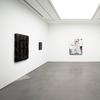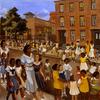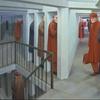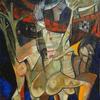Dia to Present Blinky Palermo’s 'To the People of New York City'
- NEW YORK, New York
- /
- July 16, 2018
Opening at Dia:Chelsea on September 15, 2018, Blinky Palermo’s To the People of New York City (1976) returns to New York City after thirty years. The artist’s magnum opus was last shown in the city in 1987 at Dia’s former Chelsea space. To the People of New York City is a multipartite group of paintings whose palette is derived from the black, gold, and red colors of both the East and West German flags from 1949 to 1990 and the current German flag. The work’s title was posthumously chosen from a dedication that Palermo inscribed on the backs of the panels.
“To the People of New York City has often been described as the most influential work of Palermo’s short but remarkable career—representing a complex investigation into the formal language of Minimalism and the legacy of abstraction, while foreshadowing the paradigms of Conceptual practice. In the context of Dia’s rich collection of work by both Palermo and his peers, this presentation will foster important and in-depth engagement with this artist’s rarely exhibited work,” said Jessica Morgan, Dia’s Nathalie de Gunzburg Director. “Dia Center for the Arts opened at 548 West 22nd Street in 1987 with an exhibition of Palermo’s To the People of New York City. It is fitting that thirty years later it is this presentation that will be the final exhibition at Dia’s 545 West 22nd Street location before the space undergoes a yearlong renovation as part of a comprehensive plan to revitalize our constellation of sites in New York.”
The work is part of the artist’s Metal Pictures series (or Metallbilder, in German), which he started while living in New York City from 1973 to 1976. During this time, Palermo began to compose serialized groups of paintings on metal, using color and formal patterns to focus on a specific experience of abstract progression.
Completed upon his return to Düsseldorf in late 1976, To the People of New York City was discovered in Palermo’s studio after his death in February 1977. Consisting of fifteen parts—composed from forty painted aluminum panels arranged in various combinations of black, cadmium red, and cadmium yellow—the demarcated bands of color in To the People of New York Cityread as striking, didactic signs. His choice of colored bands may reference the early twentieth-century abstract painting of Kazimir Malevich or Piet Mondrian as well as the then-divided nations of East and West Germany, whose separate flags shared the trio of colors, albeit with different designs between 1949 and 1990. Palermo had seen the bifurcation of the nation when he conceived and realized this work, but he never saw German reunification or the return to a single flag, though his multi-panel painting suggests both possibilities. To the People of New York City, however, is distinguished by the system of hanging that Palermo prescribed, which included rhythmically variable formats and a lower placement on the wall. Each of these elements refer to the variation and improvisation of jazz, one of Palermo’s frequent pastime pursuits while in New York.
In addition to the paintings, the exhibition includes a selection of Palermo’s preparatory studies—felt pen sketches on parchment paper—on which he recorded ideas about the singular arrangement of the painted panels. The studies, which have been generously loaned by the Palermo Archive for this exhibition, provide insight into the evolution of this comprehensive cycle of painting.
Blinky Palermo was born Peter Schwarze in Leipzig, Germany, in 1943. He and his twin brother, Michael, grew up as adopted children under the name Heisterkamp. In 1962 Palermo entered the Kunstakademie Düsseldorf, where he studied with Bruno Goller and Joseph Beuys. In 1964 he adopted the name Blinky Palermo, which he appropriated from Frank “Blinky” Palermo, the manager of American boxing heavyweight champion Sonny Liston. He participated in more than seventy exhibitions, including Documenta in 1972 and 1977 and the São Paulo Biennial in 1975. In 1987 his work was featured in one of the first three exhibitions at Dia’s former Chelsea location, which was located at 548 West 22nd Street. Palermo died in 1977 while traveling in the Maldives.












100x100_c.jpg)

